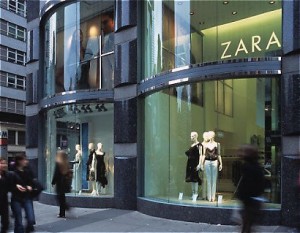similar article on Zara’s marketing strategy http://www.philau.edu/sba/news/zarareport.pdf
Zara: Cool Clothes Now, Not Later taken from: www.csus.edu/indiv/w/wilsonm/MBA%20209…/Zara_CASE.doc

lack of advertising, but this storefront attracts many customers and has a much vaunted marketing strategytaken from http://www.essentialstyleformen.com/features/feature-zara-stores/
It is wise for Zara to focus on reacting swiftly to consumer demand instead of forecasting it. Forecasting would require extensive market research which would add unnecessarily to the company’s costs. Zara’s ability to react quickly to consumer tastes and preferences is evident from how staff members get direct verbal feedback from customers and its efficiency in shipping products to stores that are strategically geographically clustered in Spain. This also makes the distribution channel choices in the simplified supply chain much more evident. Zara embodies the notion of variability, keeping in mind the probability of expected events that are going to happen.
It might seem counterintuitive to ship small stocks of clothing to stores. However, Zara compensates for this by capitalizing on the exclusivity of its clothes. There is high customer traffic as customers want to check out the regularly changing products, thus increasing stock turnover.
I admire Zara for its unconventional, yet intellectual marketing strategy. However, to successfully penetrate the US market, it would have to tweak its strategy. It would not be able to rely on the geographical proximity of its stores initially, as stores would likely be spread out over the larger geographical area.
